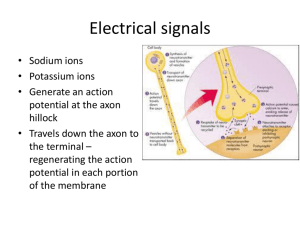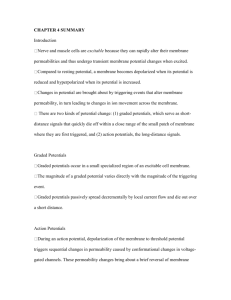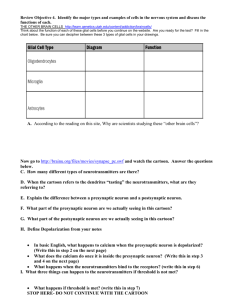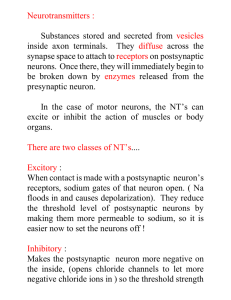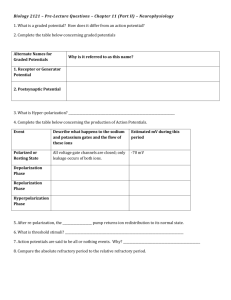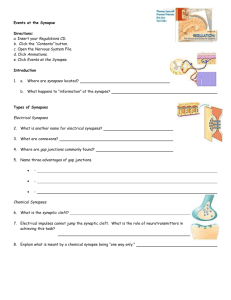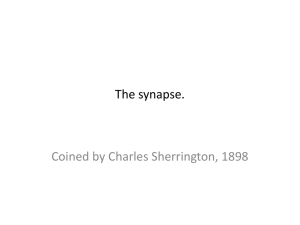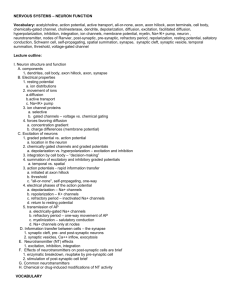How do neurons communicate?
advertisement
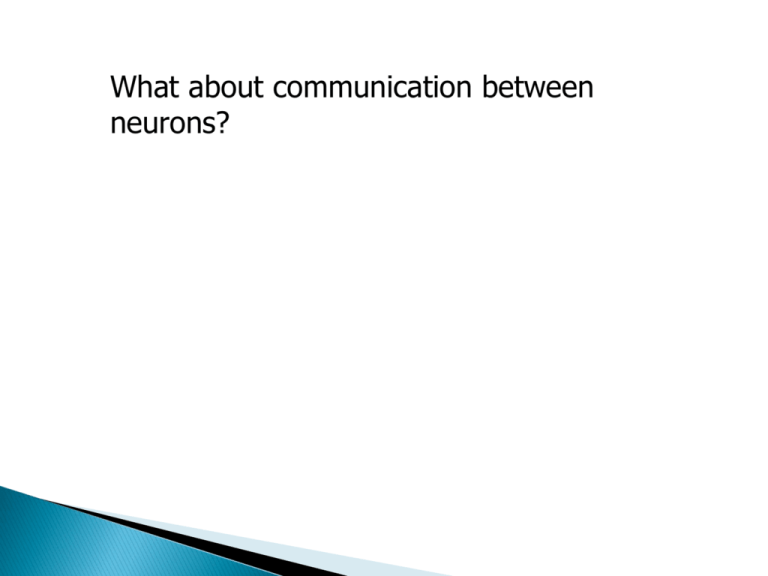
What about communication between neurons? presynaptic ending – ◦ portion of the axon conveying information to the next neuron presynaptic ending – ◦ the portion of the axon that is conveying information to the next neuron synapse or synaptic cleft ◦ the space between neurons where communication occurs presynaptic ending – ◦ the portion of the axon that is conveying information to the next neuron synapse or synaptic cleft ◦ the space between neurons where communication occurs postsynaptic membrane ◦ the portion of the neuron (usually dendrite) that receives information presynaptic ending – ◦ the portion of the axon that is conveying information to the next neuron synapse or synaptic cleft ◦ the space between neurons where communication occurs postsynaptic membrane ◦ the portion of the neuron (usually dendrite) that receives information pre and postsynaptic receptors ◦ proteins in both the presynaptic and postsynaptic ending that allow for information to be transferred synaptic vesicles --small enclosed membranes that contain neurotransmitter found in presynaptic ending neurotransmitter – substance in vesicles that are released in synapse and convey info to the next neuron synapse AP reaches presynaptic endingCa+2 channels in presynaptic ending open and Ca+2 enters Why are Ca+2 ions important? Ca+2 entry into the presynaptic ending critical for neurotransmitter release drugs that block Ca+2 channels……. protein embedded in membrane mechanism for neurotransmitter to influence postsynaptic activity by binding to receptor NT binds to postsynaptic receptors and causes small local changes in electrical potential (depolarizations or hyperpolarizations)◦ Called graded potentials increase or decrease the likelihood of the neuron receiving info to generate an action potential ◦ graded potentials that increase the likelihood of an action potential are called EPSPs (excitatory postsynaptic potentials) increase or decrease the likelihood of the neuron receiving info to generate an action potential ◦ graded potentials that increase the likelihood of an action potential are called EPSPs (excitatory postsynaptic potentials) ◦ graded potentials that decrease the likelihood of an action potential are called IPSPs (inhibitory postsynaptic potentials) NT binding to postsynaptic receptors cause local ion channels to open chemically dependent ion channels ◦ (in contrast with electrically dependent ion channels in the axon) postsynaptic receptors open ion channels – ◦ ion channels in postsynaptic membrane (that we need to worry about) include Na+, Cl- and K+ EPSPs – excitatory postsynaptic potentials - increase the likelihood of an AP - opening of IPSPs – inhibitory postsynaptic potentials decrease the likelihood of an AP - opening of http://www.blackwellpublishing.com/matthews/neurotrans.html Axon hillock ◦ graded potentials are summed at axon hillock and……if the sum is a great enough depolarization…. action potential or spike Graded Potentials and AP differ in a number of ways ◦ ◦ ◦ AP – occurs at the axon GP – occurs anywhere the neuron receives info from another neuron (usually dendrite although NOT ALWAYS) action potentials are “all or none” graded potentials decrease over space and time ◦ Graded potentials are localized – has impact in limited region; AP travels down the axon Graded potentials can either increase or decrease the likelihood of an action potential Postsynaptic receptor and NT – think about a lock and key! Neurotransmitter represents a key Receptor represents the lock directly opening the ion channel 1. ◦ occurs and terminates very quickly http://www.blackwellpublishing.com/matthews/nmj.html directly opening the ion channel 1. ◦ occurs and terminates very quickly more indirect 2. ◦ ultimately opens ion channel via stimulating a chemical reaction takes longer but lasts longer http://www.blackwellpublishing.com/matthews/neurotrans.html 1. reuptake - most common ◦ protein on presynaptic ending transports it back into the neuron that released it ◦ Means of recycling NT saving energy (neurons have to synthesize or produce their own NT) ◦ a common way for drugs to alter normal communication cocaine, amphetamine, methylphenidate (Ritalin) – block reuptake of a number of NT – particularly dopamine (reward) many of the newer antidepressants are SSRIs (selective serotonin reuptake inhibitors) enzyme degradation 2. ◦ enzyme - speeds up a reaction ◦ ex. acetylcholine (ACh)is a neurotransmitter is broken down by acetylcholinesterase (AChE) For ACh – this is done in the synapse probably 100s of “putative” neurotransmitters – more being discovered all the time role that the novel NTs play still being determined acetylcholine (ACh) – 1. • acetylcholine (ACh) – found in CNS and PNS • receptor subtypes – • nicotinic and muscarinic acetylcholine (ACh) – found in CNS and PNS • receptor subtypes – • nicotinic and muscarinic • • nicotinic receptors – muscles acetylcholine also important for various behaviors including learning and memory alzheimers disease, REM sleep, among other things… 2. Monoamines 1. dopamine (DA) important for reward circuits schizophrenia and Parkinsons disease 2. Monoamines 1. dopamine (DA) 2. norepinephrine (NE) important for arousal altered activity implicated in depression 2. Monoamines 1. dopamine (DA) 2. norepinephrine (NE) 3. serotonin (5HT) aggression, anxiety, depression 3. Peptides- really large neurotransmitters 3. Peptides 1. substance P important for pain 2. endorphins and enkephalins (endogenous opiates) pain relievers! 4. amino acids (tiny neurotransmitters) 1. glutamate ALWAYS EXCITATORY (IE always causes EPSPs) 2. GABA – always inhibitory ( always causes IPSPs) - almost any aspect of the NT function can be affected by drugs! synthesis of NT storage of NT release of NT binding of NT breakdown of NT agonist – mimics the neurotransmitter’s effect antagonist – blocks the neurotransmitter’s effect acting like a receptor agonist ◦ nicotine ionotropic potent poison acting like a receptor antagonist ◦ curare alter breakdown of ACh blocks breakdown ◦ mustard gases, insecticides, ◦ nerve gases Sarin - estimated to be over 500 times more toxic than cyanide ◦ Gulf War Syndrome? ◦ other current syndromes?? alter breakdown of ACh ◦ blocks breakdown mustard gases, insecticides, physostigmine Gulf War Syndrome? alter release of ACh ◦ block release – botulism alter release of ACh ◦ block release – botulism ◦ botox ◦ stimulate release – black widow spider venom
